Crypto-currency Taxation Report - Finance in Australia
VerifiedAdded on 2020/07/23
|9
|2695
|436
Report
AI Summary
This report provides a comprehensive overview of crypto-currency taxation in Australia. It begins by defining crypto-currency and explaining its functionality, followed by an analysis of how the Australian Tax Office (ATO) currently taxes crypto-currencies, treating them as digital commodities rather than currency. The report details the tax implications for traders and investors, particularly regarding capital gains. It further explores the role of revenue authorities in ensuring correct taxation, examining elements such as legal form, funding, and accountability. The report concludes by assessing the potential success of tax authorities' measures in regulating crypto-currencies, emphasizing the importance of record-keeping and providing guidelines to manage and control financial institutions and currencies effectively. It references various sources to support its analysis of the evolving landscape of crypto-currency taxation in Australia.
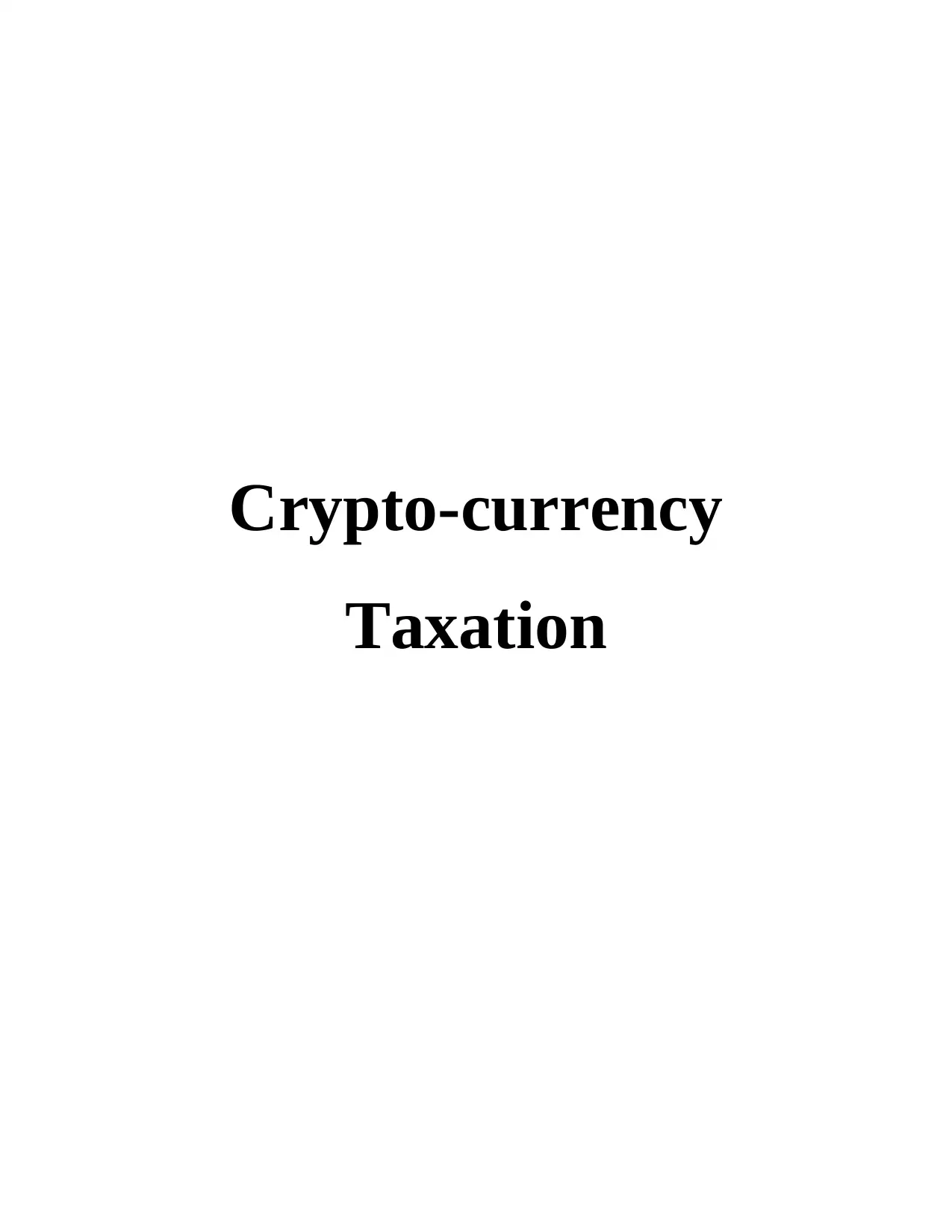
Crypto-currency
Taxation
Taxation
Paraphrase This Document
Need a fresh take? Get an instant paraphrase of this document with our AI Paraphraser
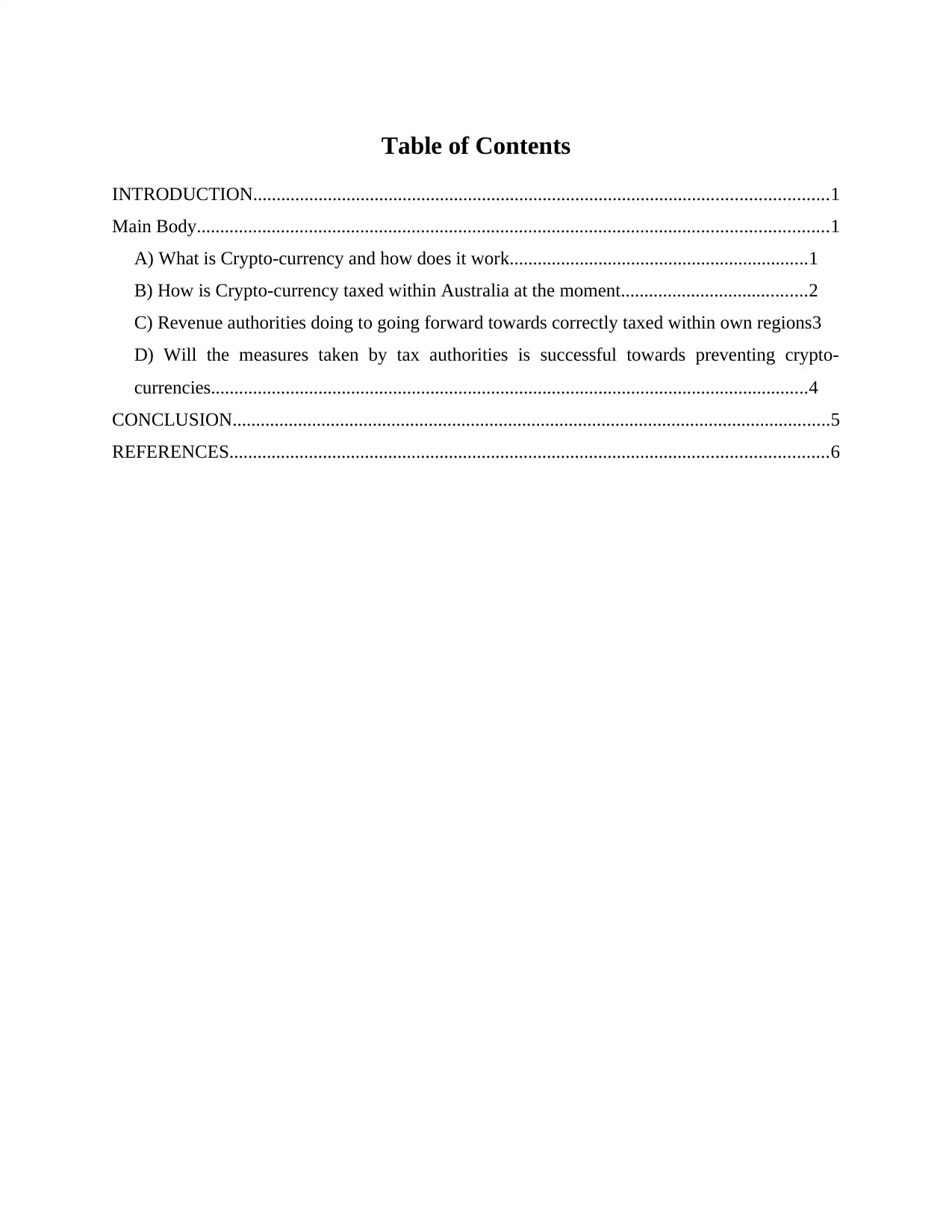
Table of Contents
INTRODUCTION...........................................................................................................................1
Main Body.......................................................................................................................................1
A) What is Crypto-currency and how does it work................................................................1
B) How is Crypto-currency taxed within Australia at the moment........................................2
C) Revenue authorities doing to going forward towards correctly taxed within own regions3
D) Will the measures taken by tax authorities is successful towards preventing crypto-
currencies................................................................................................................................4
CONCLUSION................................................................................................................................5
REFERENCES................................................................................................................................6
INTRODUCTION...........................................................................................................................1
Main Body.......................................................................................................................................1
A) What is Crypto-currency and how does it work................................................................1
B) How is Crypto-currency taxed within Australia at the moment........................................2
C) Revenue authorities doing to going forward towards correctly taxed within own regions3
D) Will the measures taken by tax authorities is successful towards preventing crypto-
currencies................................................................................................................................4
CONCLUSION................................................................................................................................5
REFERENCES................................................................................................................................6
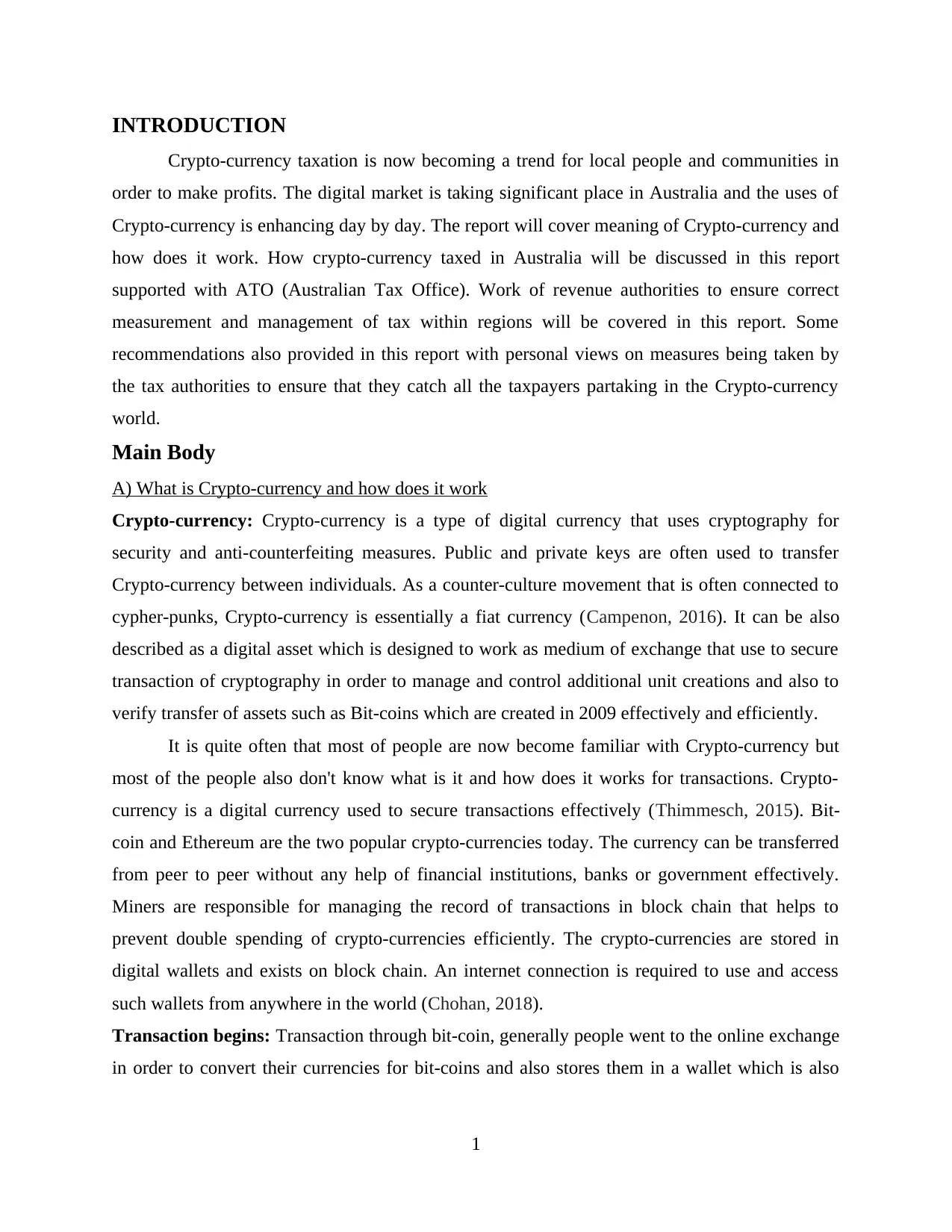
INTRODUCTION
Crypto-currency taxation is now becoming a trend for local people and communities in
order to make profits. The digital market is taking significant place in Australia and the uses of
Crypto-currency is enhancing day by day. The report will cover meaning of Crypto-currency and
how does it work. How crypto-currency taxed in Australia will be discussed in this report
supported with ATO (Australian Tax Office). Work of revenue authorities to ensure correct
measurement and management of tax within regions will be covered in this report. Some
recommendations also provided in this report with personal views on measures being taken by
the tax authorities to ensure that they catch all the taxpayers partaking in the Crypto-currency
world.
Main Body
A) What is Crypto-currency and how does it work
Crypto-currency: Crypto-currency is a type of digital currency that uses cryptography for
security and anti-counterfeiting measures. Public and private keys are often used to transfer
Crypto-currency between individuals. As a counter-culture movement that is often connected to
cypher-punks, Crypto-currency is essentially a fiat currency (Campenon, 2016). It can be also
described as a digital asset which is designed to work as medium of exchange that use to secure
transaction of cryptography in order to manage and control additional unit creations and also to
verify transfer of assets such as Bit-coins which are created in 2009 effectively and efficiently.
It is quite often that most of people are now become familiar with Crypto-currency but
most of the people also don't know what is it and how does it works for transactions. Crypto-
currency is a digital currency used to secure transactions effectively (Thimmesch, 2015). Bit-
coin and Ethereum are the two popular crypto-currencies today. The currency can be transferred
from peer to peer without any help of financial institutions, banks or government effectively.
Miners are responsible for managing the record of transactions in block chain that helps to
prevent double spending of crypto-currencies efficiently. The crypto-currencies are stored in
digital wallets and exists on block chain. An internet connection is required to use and access
such wallets from anywhere in the world (Chohan, 2018).
Transaction begins: Transaction through bit-coin, generally people went to the online exchange
in order to convert their currencies for bit-coins and also stores them in a wallet which is also
1
Crypto-currency taxation is now becoming a trend for local people and communities in
order to make profits. The digital market is taking significant place in Australia and the uses of
Crypto-currency is enhancing day by day. The report will cover meaning of Crypto-currency and
how does it work. How crypto-currency taxed in Australia will be discussed in this report
supported with ATO (Australian Tax Office). Work of revenue authorities to ensure correct
measurement and management of tax within regions will be covered in this report. Some
recommendations also provided in this report with personal views on measures being taken by
the tax authorities to ensure that they catch all the taxpayers partaking in the Crypto-currency
world.
Main Body
A) What is Crypto-currency and how does it work
Crypto-currency: Crypto-currency is a type of digital currency that uses cryptography for
security and anti-counterfeiting measures. Public and private keys are often used to transfer
Crypto-currency between individuals. As a counter-culture movement that is often connected to
cypher-punks, Crypto-currency is essentially a fiat currency (Campenon, 2016). It can be also
described as a digital asset which is designed to work as medium of exchange that use to secure
transaction of cryptography in order to manage and control additional unit creations and also to
verify transfer of assets such as Bit-coins which are created in 2009 effectively and efficiently.
It is quite often that most of people are now become familiar with Crypto-currency but
most of the people also don't know what is it and how does it works for transactions. Crypto-
currency is a digital currency used to secure transactions effectively (Thimmesch, 2015). Bit-
coin and Ethereum are the two popular crypto-currencies today. The currency can be transferred
from peer to peer without any help of financial institutions, banks or government effectively.
Miners are responsible for managing the record of transactions in block chain that helps to
prevent double spending of crypto-currencies efficiently. The crypto-currencies are stored in
digital wallets and exists on block chain. An internet connection is required to use and access
such wallets from anywhere in the world (Chohan, 2018).
Transaction begins: Transaction through bit-coin, generally people went to the online exchange
in order to convert their currencies for bit-coins and also stores them in a wallet which is also
1
⊘ This is a preview!⊘
Do you want full access?
Subscribe today to unlock all pages.

Trusted by 1+ million students worldwide
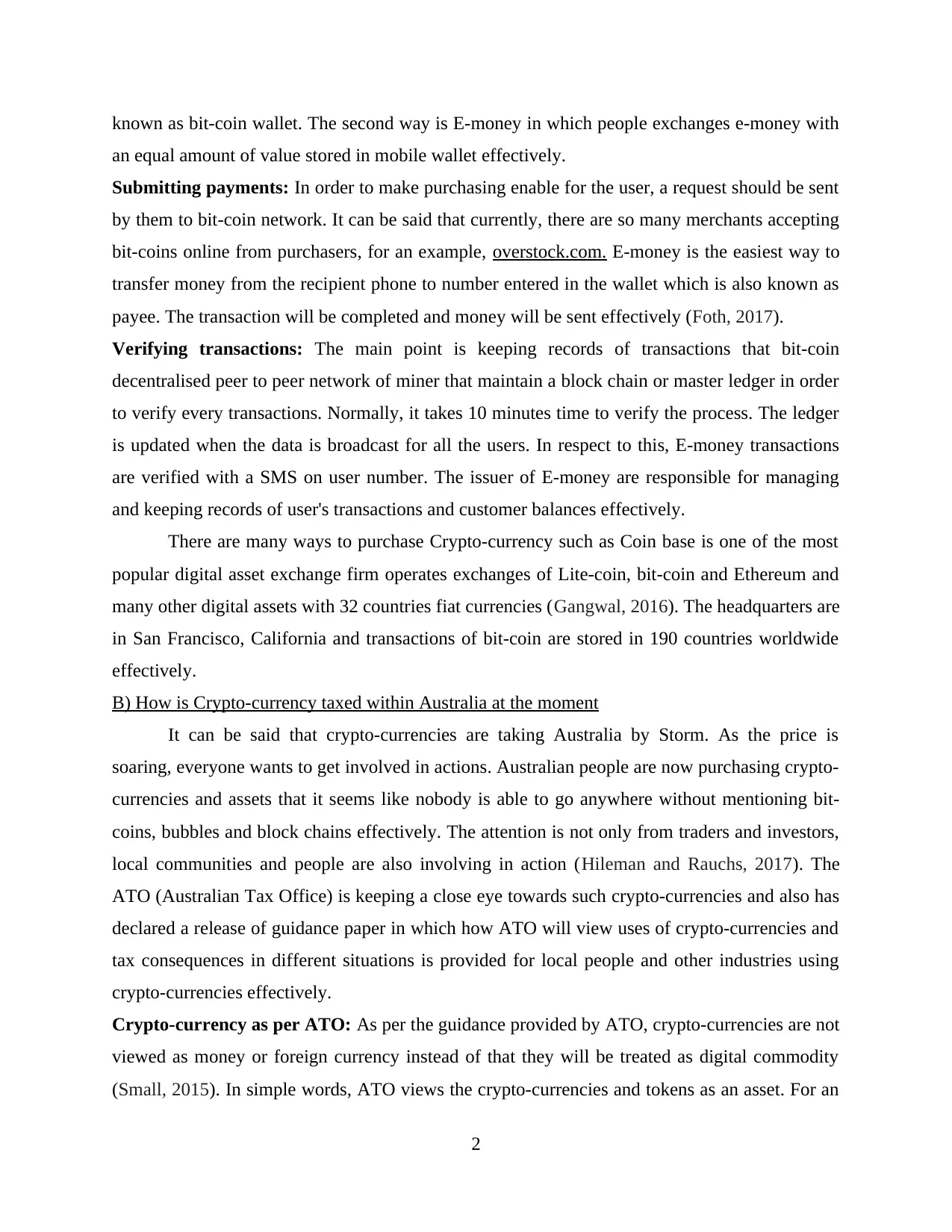
known as bit-coin wallet. The second way is E-money in which people exchanges e-money with
an equal amount of value stored in mobile wallet effectively.
Submitting payments: In order to make purchasing enable for the user, a request should be sent
by them to bit-coin network. It can be said that currently, there are so many merchants accepting
bit-coins online from purchasers, for an example, overstock.com. E-money is the easiest way to
transfer money from the recipient phone to number entered in the wallet which is also known as
payee. The transaction will be completed and money will be sent effectively (Foth, 2017).
Verifying transactions: The main point is keeping records of transactions that bit-coin
decentralised peer to peer network of miner that maintain a block chain or master ledger in order
to verify every transactions. Normally, it takes 10 minutes time to verify the process. The ledger
is updated when the data is broadcast for all the users. In respect to this, E-money transactions
are verified with a SMS on user number. The issuer of E-money are responsible for managing
and keeping records of user's transactions and customer balances effectively.
There are many ways to purchase Crypto-currency such as Coin base is one of the most
popular digital asset exchange firm operates exchanges of Lite-coin, bit-coin and Ethereum and
many other digital assets with 32 countries fiat currencies (Gangwal, 2016). The headquarters are
in San Francisco, California and transactions of bit-coin are stored in 190 countries worldwide
effectively.
B) How is Crypto-currency taxed within Australia at the moment
It can be said that crypto-currencies are taking Australia by Storm. As the price is
soaring, everyone wants to get involved in actions. Australian people are now purchasing crypto-
currencies and assets that it seems like nobody is able to go anywhere without mentioning bit-
coins, bubbles and block chains effectively. The attention is not only from traders and investors,
local communities and people are also involving in action (Hileman and Rauchs, 2017). The
ATO (Australian Tax Office) is keeping a close eye towards such crypto-currencies and also has
declared a release of guidance paper in which how ATO will view uses of crypto-currencies and
tax consequences in different situations is provided for local people and other industries using
crypto-currencies effectively.
Crypto-currency as per ATO: As per the guidance provided by ATO, crypto-currencies are not
viewed as money or foreign currency instead of that they will be treated as digital commodity
(Small, 2015). In simple words, ATO views the crypto-currencies and tokens as an asset. For an
2
an equal amount of value stored in mobile wallet effectively.
Submitting payments: In order to make purchasing enable for the user, a request should be sent
by them to bit-coin network. It can be said that currently, there are so many merchants accepting
bit-coins online from purchasers, for an example, overstock.com. E-money is the easiest way to
transfer money from the recipient phone to number entered in the wallet which is also known as
payee. The transaction will be completed and money will be sent effectively (Foth, 2017).
Verifying transactions: The main point is keeping records of transactions that bit-coin
decentralised peer to peer network of miner that maintain a block chain or master ledger in order
to verify every transactions. Normally, it takes 10 minutes time to verify the process. The ledger
is updated when the data is broadcast for all the users. In respect to this, E-money transactions
are verified with a SMS on user number. The issuer of E-money are responsible for managing
and keeping records of user's transactions and customer balances effectively.
There are many ways to purchase Crypto-currency such as Coin base is one of the most
popular digital asset exchange firm operates exchanges of Lite-coin, bit-coin and Ethereum and
many other digital assets with 32 countries fiat currencies (Gangwal, 2016). The headquarters are
in San Francisco, California and transactions of bit-coin are stored in 190 countries worldwide
effectively.
B) How is Crypto-currency taxed within Australia at the moment
It can be said that crypto-currencies are taking Australia by Storm. As the price is
soaring, everyone wants to get involved in actions. Australian people are now purchasing crypto-
currencies and assets that it seems like nobody is able to go anywhere without mentioning bit-
coins, bubbles and block chains effectively. The attention is not only from traders and investors,
local communities and people are also involving in action (Hileman and Rauchs, 2017). The
ATO (Australian Tax Office) is keeping a close eye towards such crypto-currencies and also has
declared a release of guidance paper in which how ATO will view uses of crypto-currencies and
tax consequences in different situations is provided for local people and other industries using
crypto-currencies effectively.
Crypto-currency as per ATO: As per the guidance provided by ATO, crypto-currencies are not
viewed as money or foreign currency instead of that they will be treated as digital commodity
(Small, 2015). In simple words, ATO views the crypto-currencies and tokens as an asset. For an
2
Paraphrase This Document
Need a fresh take? Get an instant paraphrase of this document with our AI Paraphraser
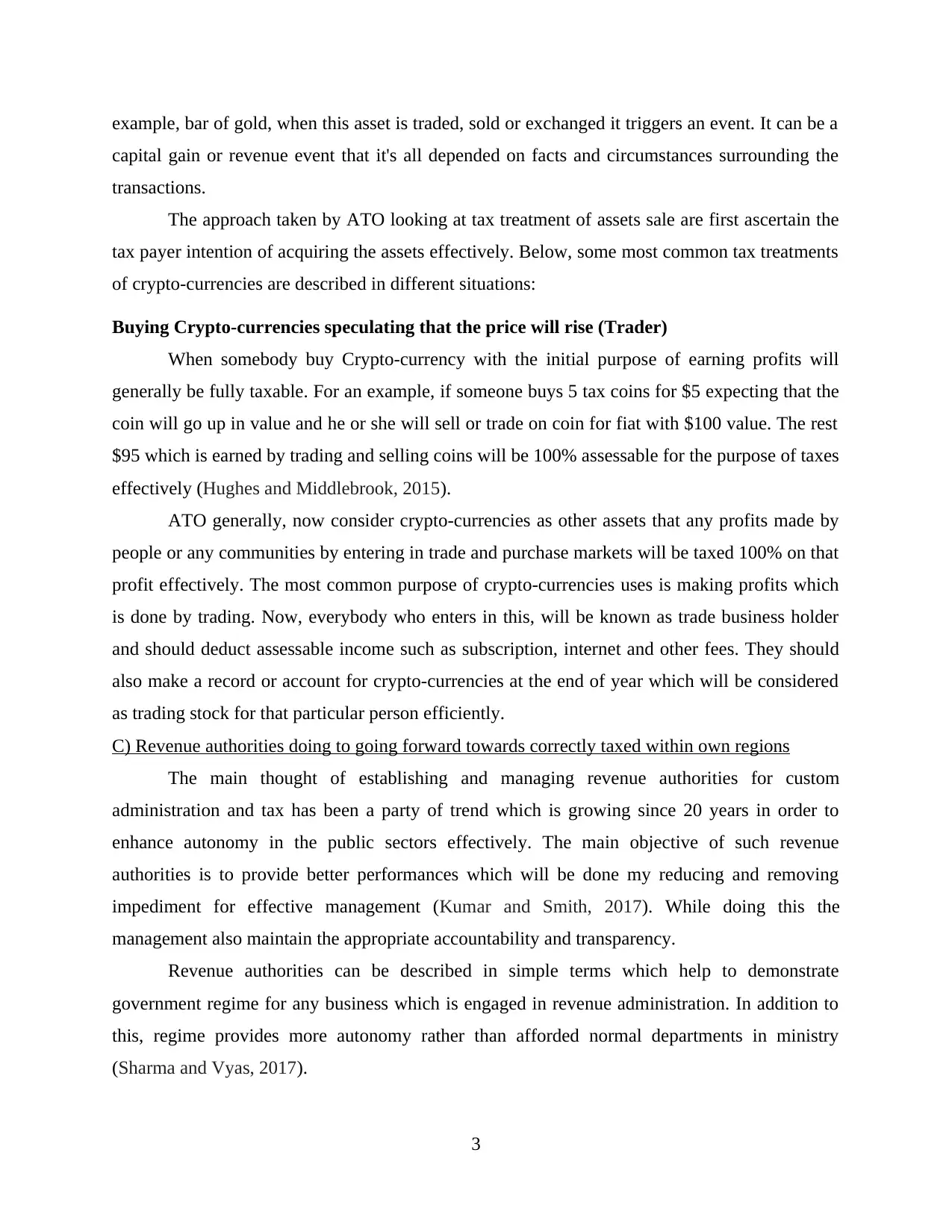
example, bar of gold, when this asset is traded, sold or exchanged it triggers an event. It can be a
capital gain or revenue event that it's all depended on facts and circumstances surrounding the
transactions.
The approach taken by ATO looking at tax treatment of assets sale are first ascertain the
tax payer intention of acquiring the assets effectively. Below, some most common tax treatments
of crypto-currencies are described in different situations:
Buying Crypto-currencies speculating that the price will rise (Trader)
When somebody buy Crypto-currency with the initial purpose of earning profits will
generally be fully taxable. For an example, if someone buys 5 tax coins for $5 expecting that the
coin will go up in value and he or she will sell or trade on coin for fiat with $100 value. The rest
$95 which is earned by trading and selling coins will be 100% assessable for the purpose of taxes
effectively (Hughes and Middlebrook, 2015).
ATO generally, now consider crypto-currencies as other assets that any profits made by
people or any communities by entering in trade and purchase markets will be taxed 100% on that
profit effectively. The most common purpose of crypto-currencies uses is making profits which
is done by trading. Now, everybody who enters in this, will be known as trade business holder
and should deduct assessable income such as subscription, internet and other fees. They should
also make a record or account for crypto-currencies at the end of year which will be considered
as trading stock for that particular person efficiently.
C) Revenue authorities doing to going forward towards correctly taxed within own regions
The main thought of establishing and managing revenue authorities for custom
administration and tax has been a party of trend which is growing since 20 years in order to
enhance autonomy in the public sectors effectively. The main objective of such revenue
authorities is to provide better performances which will be done my reducing and removing
impediment for effective management (Kumar and Smith, 2017). While doing this the
management also maintain the appropriate accountability and transparency.
Revenue authorities can be described in simple terms which help to demonstrate
government regime for any business which is engaged in revenue administration. In addition to
this, regime provides more autonomy rather than afforded normal departments in ministry
(Sharma and Vyas, 2017).
3
capital gain or revenue event that it's all depended on facts and circumstances surrounding the
transactions.
The approach taken by ATO looking at tax treatment of assets sale are first ascertain the
tax payer intention of acquiring the assets effectively. Below, some most common tax treatments
of crypto-currencies are described in different situations:
Buying Crypto-currencies speculating that the price will rise (Trader)
When somebody buy Crypto-currency with the initial purpose of earning profits will
generally be fully taxable. For an example, if someone buys 5 tax coins for $5 expecting that the
coin will go up in value and he or she will sell or trade on coin for fiat with $100 value. The rest
$95 which is earned by trading and selling coins will be 100% assessable for the purpose of taxes
effectively (Hughes and Middlebrook, 2015).
ATO generally, now consider crypto-currencies as other assets that any profits made by
people or any communities by entering in trade and purchase markets will be taxed 100% on that
profit effectively. The most common purpose of crypto-currencies uses is making profits which
is done by trading. Now, everybody who enters in this, will be known as trade business holder
and should deduct assessable income such as subscription, internet and other fees. They should
also make a record or account for crypto-currencies at the end of year which will be considered
as trading stock for that particular person efficiently.
C) Revenue authorities doing to going forward towards correctly taxed within own regions
The main thought of establishing and managing revenue authorities for custom
administration and tax has been a party of trend which is growing since 20 years in order to
enhance autonomy in the public sectors effectively. The main objective of such revenue
authorities is to provide better performances which will be done my reducing and removing
impediment for effective management (Kumar and Smith, 2017). While doing this the
management also maintain the appropriate accountability and transparency.
Revenue authorities can be described in simple terms which help to demonstrate
government regime for any business which is engaged in revenue administration. In addition to
this, regime provides more autonomy rather than afforded normal departments in ministry
(Sharma and Vyas, 2017).
3
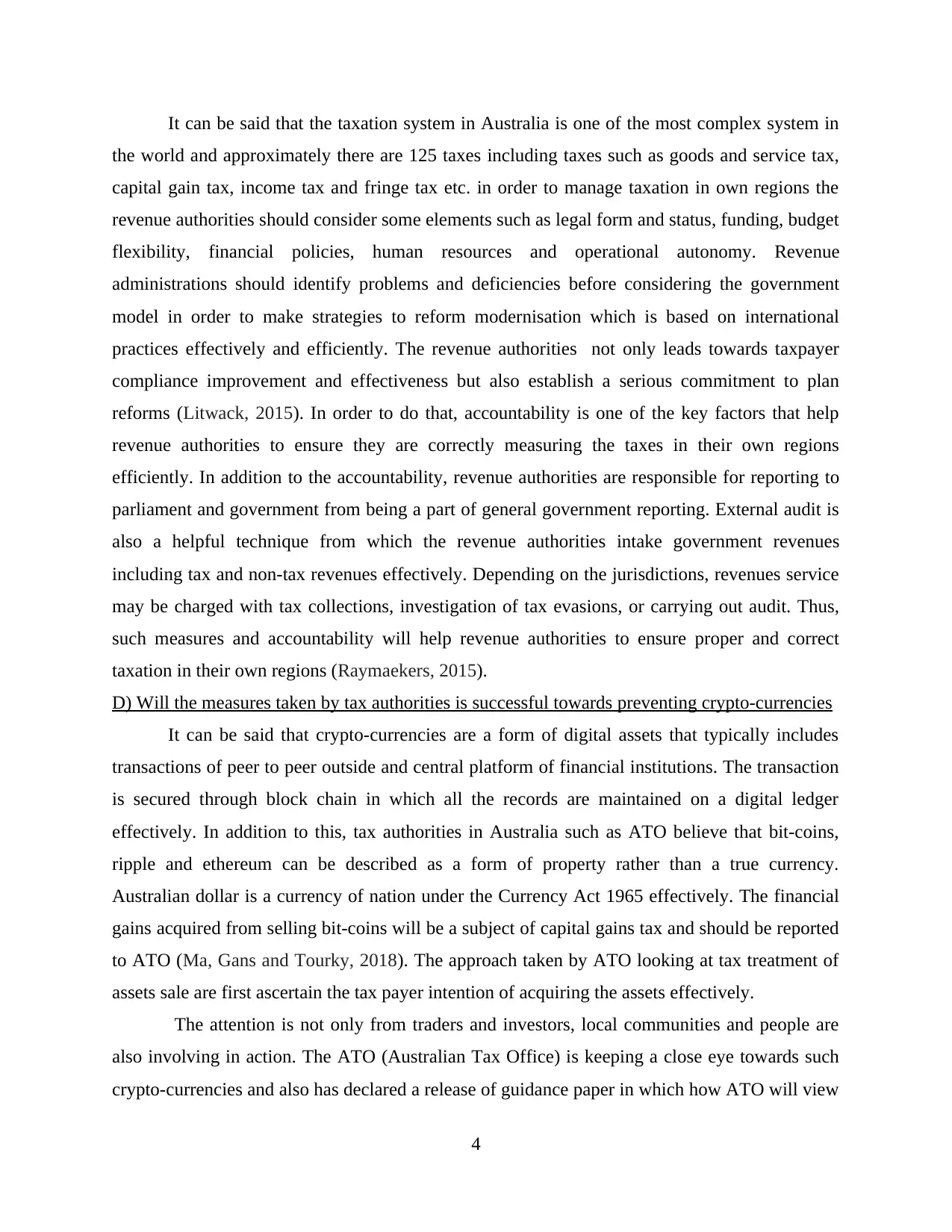
It can be said that the taxation system in Australia is one of the most complex system in
the world and approximately there are 125 taxes including taxes such as goods and service tax,
capital gain tax, income tax and fringe tax etc. in order to manage taxation in own regions the
revenue authorities should consider some elements such as legal form and status, funding, budget
flexibility, financial policies, human resources and operational autonomy. Revenue
administrations should identify problems and deficiencies before considering the government
model in order to make strategies to reform modernisation which is based on international
practices effectively and efficiently. The revenue authorities not only leads towards taxpayer
compliance improvement and effectiveness but also establish a serious commitment to plan
reforms (Litwack, 2015). In order to do that, accountability is one of the key factors that help
revenue authorities to ensure they are correctly measuring the taxes in their own regions
efficiently. In addition to the accountability, revenue authorities are responsible for reporting to
parliament and government from being a part of general government reporting. External audit is
also a helpful technique from which the revenue authorities intake government revenues
including tax and non-tax revenues effectively. Depending on the jurisdictions, revenues service
may be charged with tax collections, investigation of tax evasions, or carrying out audit. Thus,
such measures and accountability will help revenue authorities to ensure proper and correct
taxation in their own regions (Raymaekers, 2015).
D) Will the measures taken by tax authorities is successful towards preventing crypto-currencies
It can be said that crypto-currencies are a form of digital assets that typically includes
transactions of peer to peer outside and central platform of financial institutions. The transaction
is secured through block chain in which all the records are maintained on a digital ledger
effectively. In addition to this, tax authorities in Australia such as ATO believe that bit-coins,
ripple and ethereum can be described as a form of property rather than a true currency.
Australian dollar is a currency of nation under the Currency Act 1965 effectively. The financial
gains acquired from selling bit-coins will be a subject of capital gains tax and should be reported
to ATO (Ma, Gans and Tourky, 2018). The approach taken by ATO looking at tax treatment of
assets sale are first ascertain the tax payer intention of acquiring the assets effectively.
The attention is not only from traders and investors, local communities and people are
also involving in action. The ATO (Australian Tax Office) is keeping a close eye towards such
crypto-currencies and also has declared a release of guidance paper in which how ATO will view
4
the world and approximately there are 125 taxes including taxes such as goods and service tax,
capital gain tax, income tax and fringe tax etc. in order to manage taxation in own regions the
revenue authorities should consider some elements such as legal form and status, funding, budget
flexibility, financial policies, human resources and operational autonomy. Revenue
administrations should identify problems and deficiencies before considering the government
model in order to make strategies to reform modernisation which is based on international
practices effectively and efficiently. The revenue authorities not only leads towards taxpayer
compliance improvement and effectiveness but also establish a serious commitment to plan
reforms (Litwack, 2015). In order to do that, accountability is one of the key factors that help
revenue authorities to ensure they are correctly measuring the taxes in their own regions
efficiently. In addition to the accountability, revenue authorities are responsible for reporting to
parliament and government from being a part of general government reporting. External audit is
also a helpful technique from which the revenue authorities intake government revenues
including tax and non-tax revenues effectively. Depending on the jurisdictions, revenues service
may be charged with tax collections, investigation of tax evasions, or carrying out audit. Thus,
such measures and accountability will help revenue authorities to ensure proper and correct
taxation in their own regions (Raymaekers, 2015).
D) Will the measures taken by tax authorities is successful towards preventing crypto-currencies
It can be said that crypto-currencies are a form of digital assets that typically includes
transactions of peer to peer outside and central platform of financial institutions. The transaction
is secured through block chain in which all the records are maintained on a digital ledger
effectively. In addition to this, tax authorities in Australia such as ATO believe that bit-coins,
ripple and ethereum can be described as a form of property rather than a true currency.
Australian dollar is a currency of nation under the Currency Act 1965 effectively. The financial
gains acquired from selling bit-coins will be a subject of capital gains tax and should be reported
to ATO (Ma, Gans and Tourky, 2018). The approach taken by ATO looking at tax treatment of
assets sale are first ascertain the tax payer intention of acquiring the assets effectively.
The attention is not only from traders and investors, local communities and people are
also involving in action. The ATO (Australian Tax Office) is keeping a close eye towards such
crypto-currencies and also has declared a release of guidance paper in which how ATO will view
4
⊘ This is a preview!⊘
Do you want full access?
Subscribe today to unlock all pages.

Trusted by 1+ million students worldwide
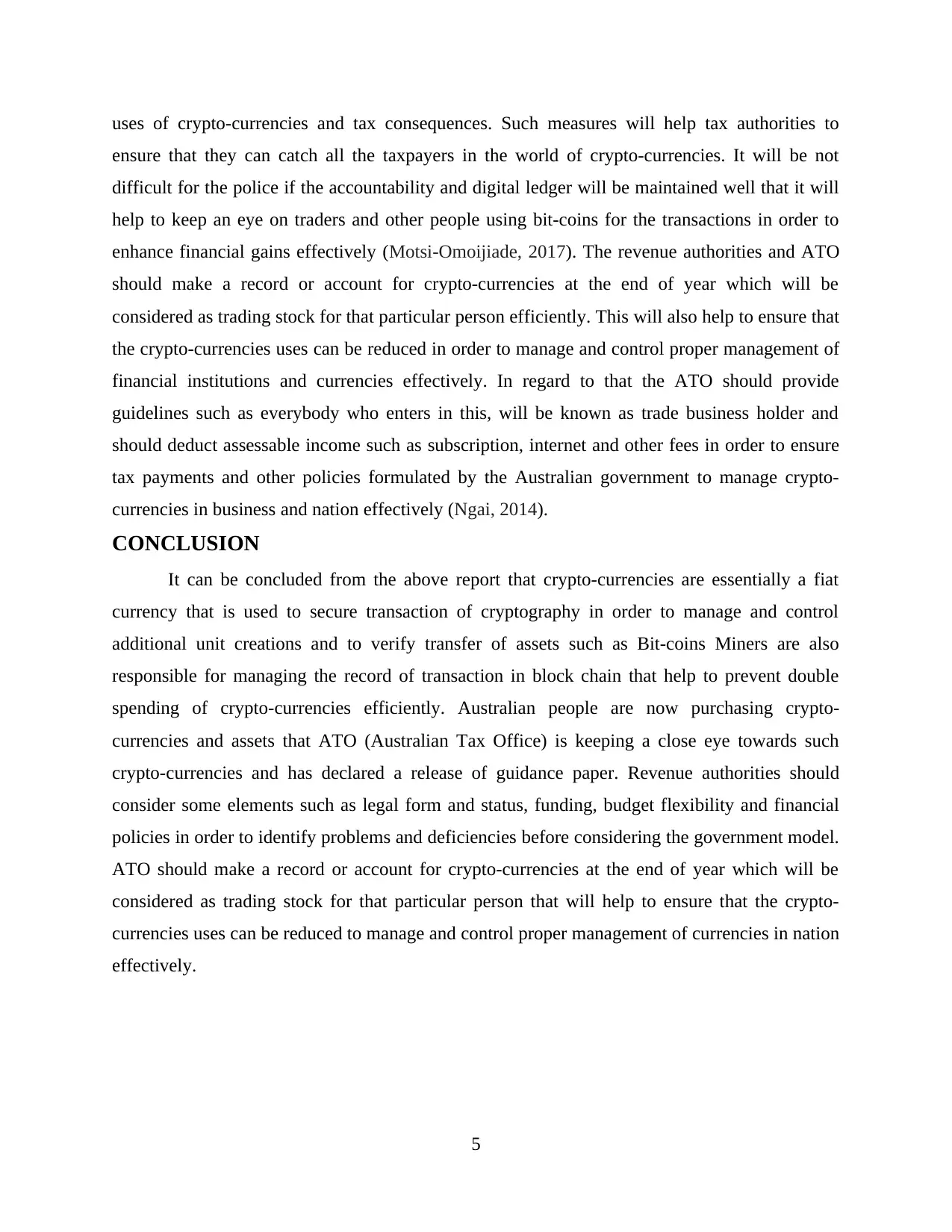
uses of crypto-currencies and tax consequences. Such measures will help tax authorities to
ensure that they can catch all the taxpayers in the world of crypto-currencies. It will be not
difficult for the police if the accountability and digital ledger will be maintained well that it will
help to keep an eye on traders and other people using bit-coins for the transactions in order to
enhance financial gains effectively (Motsi-Omoijiade, 2017). The revenue authorities and ATO
should make a record or account for crypto-currencies at the end of year which will be
considered as trading stock for that particular person efficiently. This will also help to ensure that
the crypto-currencies uses can be reduced in order to manage and control proper management of
financial institutions and currencies effectively. In regard to that the ATO should provide
guidelines such as everybody who enters in this, will be known as trade business holder and
should deduct assessable income such as subscription, internet and other fees in order to ensure
tax payments and other policies formulated by the Australian government to manage crypto-
currencies in business and nation effectively (Ngai, 2014).
CONCLUSION
It can be concluded from the above report that crypto-currencies are essentially a fiat
currency that is used to secure transaction of cryptography in order to manage and control
additional unit creations and to verify transfer of assets such as Bit-coins Miners are also
responsible for managing the record of transaction in block chain that help to prevent double
spending of crypto-currencies efficiently. Australian people are now purchasing crypto-
currencies and assets that ATO (Australian Tax Office) is keeping a close eye towards such
crypto-currencies and has declared a release of guidance paper. Revenue authorities should
consider some elements such as legal form and status, funding, budget flexibility and financial
policies in order to identify problems and deficiencies before considering the government model.
ATO should make a record or account for crypto-currencies at the end of year which will be
considered as trading stock for that particular person that will help to ensure that the crypto-
currencies uses can be reduced to manage and control proper management of currencies in nation
effectively.
5
ensure that they can catch all the taxpayers in the world of crypto-currencies. It will be not
difficult for the police if the accountability and digital ledger will be maintained well that it will
help to keep an eye on traders and other people using bit-coins for the transactions in order to
enhance financial gains effectively (Motsi-Omoijiade, 2017). The revenue authorities and ATO
should make a record or account for crypto-currencies at the end of year which will be
considered as trading stock for that particular person efficiently. This will also help to ensure that
the crypto-currencies uses can be reduced in order to manage and control proper management of
financial institutions and currencies effectively. In regard to that the ATO should provide
guidelines such as everybody who enters in this, will be known as trade business holder and
should deduct assessable income such as subscription, internet and other fees in order to ensure
tax payments and other policies formulated by the Australian government to manage crypto-
currencies in business and nation effectively (Ngai, 2014).
CONCLUSION
It can be concluded from the above report that crypto-currencies are essentially a fiat
currency that is used to secure transaction of cryptography in order to manage and control
additional unit creations and to verify transfer of assets such as Bit-coins Miners are also
responsible for managing the record of transaction in block chain that help to prevent double
spending of crypto-currencies efficiently. Australian people are now purchasing crypto-
currencies and assets that ATO (Australian Tax Office) is keeping a close eye towards such
crypto-currencies and has declared a release of guidance paper. Revenue authorities should
consider some elements such as legal form and status, funding, budget flexibility and financial
policies in order to identify problems and deficiencies before considering the government model.
ATO should make a record or account for crypto-currencies at the end of year which will be
considered as trading stock for that particular person that will help to ensure that the crypto-
currencies uses can be reduced to manage and control proper management of currencies in nation
effectively.
5
Paraphrase This Document
Need a fresh take? Get an instant paraphrase of this document with our AI Paraphraser
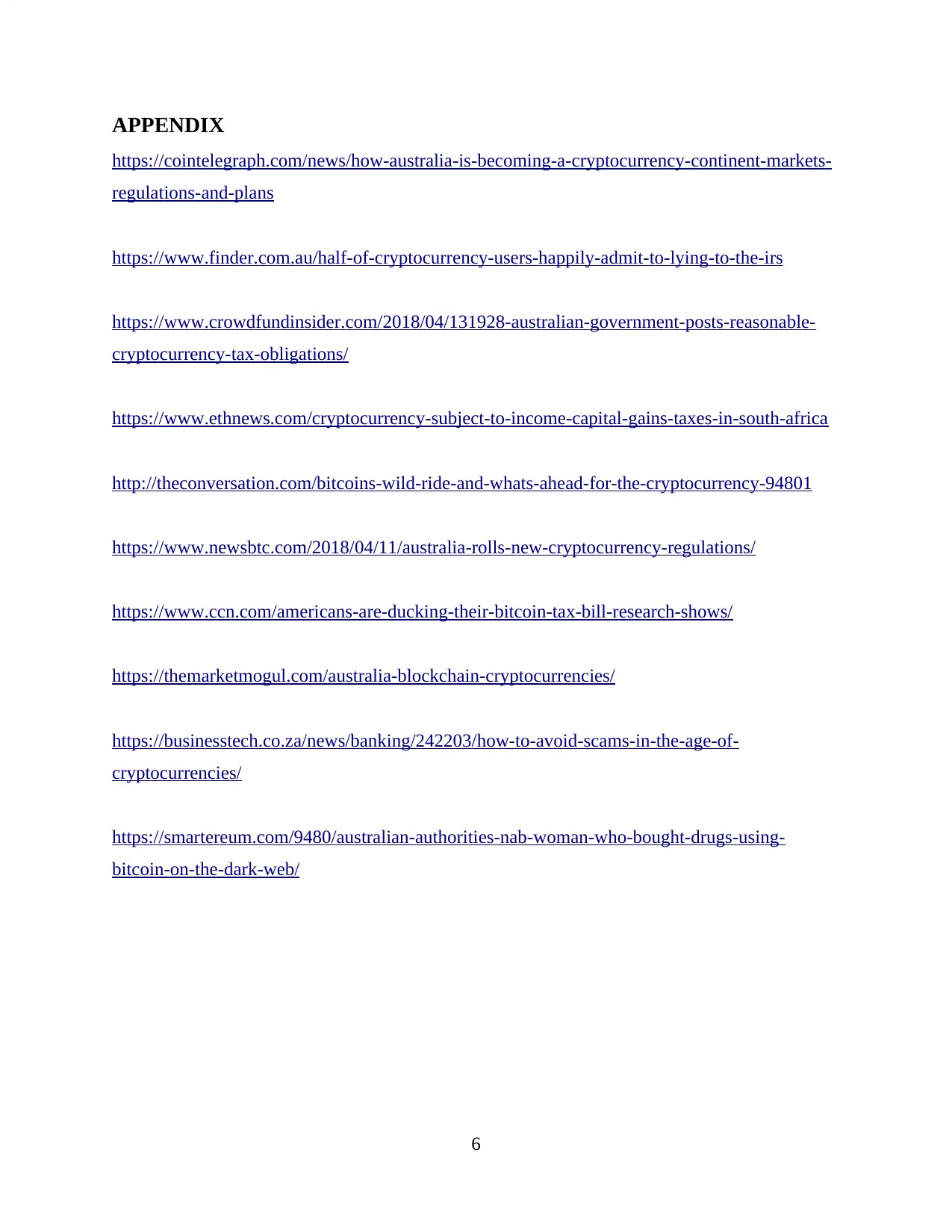
APPENDIX
https://cointelegraph.com/news/how-australia-is-becoming-a-cryptocurrency-continent-markets-
regulations-and-plans
https://www.finder.com.au/half-of-cryptocurrency-users-happily-admit-to-lying-to-the-irs
https://www.crowdfundinsider.com/2018/04/131928-australian-government-posts-reasonable-
cryptocurrency-tax-obligations/
https://www.ethnews.com/cryptocurrency-subject-to-income-capital-gains-taxes-in-south-africa
http://theconversation.com/bitcoins-wild-ride-and-whats-ahead-for-the-cryptocurrency-94801
https://www.newsbtc.com/2018/04/11/australia-rolls-new-cryptocurrency-regulations/
https://www.ccn.com/americans-are-ducking-their-bitcoin-tax-bill-research-shows/
https://themarketmogul.com/australia-blockchain-cryptocurrencies/
https://businesstech.co.za/news/banking/242203/how-to-avoid-scams-in-the-age-of-
cryptocurrencies/
https://smartereum.com/9480/australian-authorities-nab-woman-who-bought-drugs-using-
bitcoin-on-the-dark-web/
6
https://cointelegraph.com/news/how-australia-is-becoming-a-cryptocurrency-continent-markets-
regulations-and-plans
https://www.finder.com.au/half-of-cryptocurrency-users-happily-admit-to-lying-to-the-irs
https://www.crowdfundinsider.com/2018/04/131928-australian-government-posts-reasonable-
cryptocurrency-tax-obligations/
https://www.ethnews.com/cryptocurrency-subject-to-income-capital-gains-taxes-in-south-africa
http://theconversation.com/bitcoins-wild-ride-and-whats-ahead-for-the-cryptocurrency-94801
https://www.newsbtc.com/2018/04/11/australia-rolls-new-cryptocurrency-regulations/
https://www.ccn.com/americans-are-ducking-their-bitcoin-tax-bill-research-shows/
https://themarketmogul.com/australia-blockchain-cryptocurrencies/
https://businesstech.co.za/news/banking/242203/how-to-avoid-scams-in-the-age-of-
cryptocurrencies/
https://smartereum.com/9480/australian-authorities-nab-woman-who-bought-drugs-using-
bitcoin-on-the-dark-web/
6
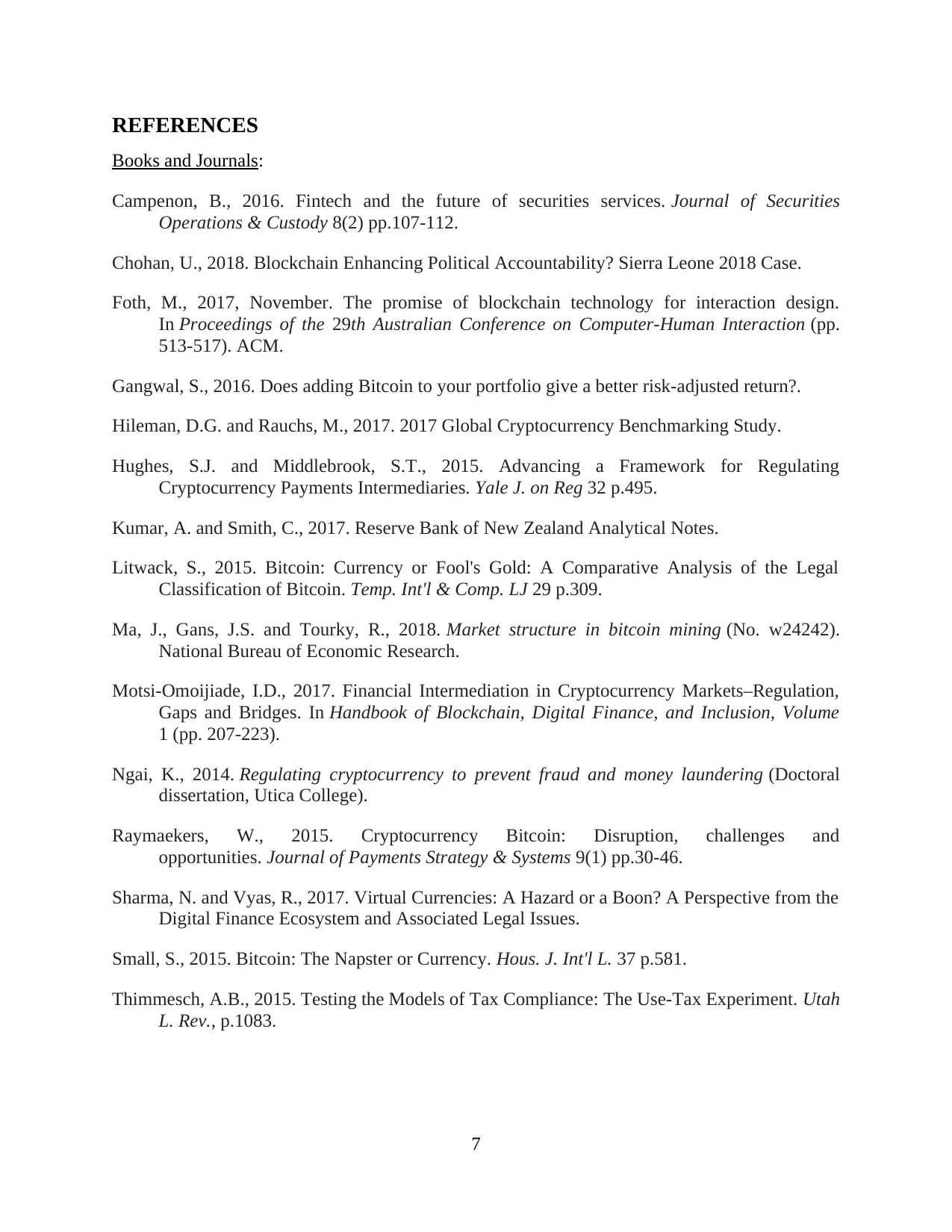
REFERENCES
Books and Journals:
Campenon, B., 2016. Fintech and the future of securities services. Journal of Securities
Operations & Custody 8(2) pp.107-112.
Chohan, U., 2018. Blockchain Enhancing Political Accountability? Sierra Leone 2018 Case.
Foth, M., 2017, November. The promise of blockchain technology for interaction design.
In Proceedings of the 29th Australian Conference on Computer-Human Interaction (pp.
513-517). ACM.
Gangwal, S., 2016. Does adding Bitcoin to your portfolio give a better risk-adjusted return?.
Hileman, D.G. and Rauchs, M., 2017. 2017 Global Cryptocurrency Benchmarking Study.
Hughes, S.J. and Middlebrook, S.T., 2015. Advancing a Framework for Regulating
Cryptocurrency Payments Intermediaries. Yale J. on Reg 32 p.495.
Kumar, A. and Smith, C., 2017. Reserve Bank of New Zealand Analytical Notes.
Litwack, S., 2015. Bitcoin: Currency or Fool's Gold: A Comparative Analysis of the Legal
Classification of Bitcoin. Temp. Int'l & Comp. LJ 29 p.309.
Ma, J., Gans, J.S. and Tourky, R., 2018. Market structure in bitcoin mining (No. w24242).
National Bureau of Economic Research.
Motsi-Omoijiade, I.D., 2017. Financial Intermediation in Cryptocurrency Markets–Regulation,
Gaps and Bridges. In Handbook of Blockchain, Digital Finance, and Inclusion, Volume
1 (pp. 207-223).
Ngai, K., 2014. Regulating cryptocurrency to prevent fraud and money laundering (Doctoral
dissertation, Utica College).
Raymaekers, W., 2015. Cryptocurrency Bitcoin: Disruption, challenges and
opportunities. Journal of Payments Strategy & Systems 9(1) pp.30-46.
Sharma, N. and Vyas, R., 2017. Virtual Currencies: A Hazard or a Boon? A Perspective from the
Digital Finance Ecosystem and Associated Legal Issues.
Small, S., 2015. Bitcoin: The Napster or Currency. Hous. J. Int'l L. 37 p.581.
Thimmesch, A.B., 2015. Testing the Models of Tax Compliance: The Use-Tax Experiment. Utah
L. Rev., p.1083.
7
Books and Journals:
Campenon, B., 2016. Fintech and the future of securities services. Journal of Securities
Operations & Custody 8(2) pp.107-112.
Chohan, U., 2018. Blockchain Enhancing Political Accountability? Sierra Leone 2018 Case.
Foth, M., 2017, November. The promise of blockchain technology for interaction design.
In Proceedings of the 29th Australian Conference on Computer-Human Interaction (pp.
513-517). ACM.
Gangwal, S., 2016. Does adding Bitcoin to your portfolio give a better risk-adjusted return?.
Hileman, D.G. and Rauchs, M., 2017. 2017 Global Cryptocurrency Benchmarking Study.
Hughes, S.J. and Middlebrook, S.T., 2015. Advancing a Framework for Regulating
Cryptocurrency Payments Intermediaries. Yale J. on Reg 32 p.495.
Kumar, A. and Smith, C., 2017. Reserve Bank of New Zealand Analytical Notes.
Litwack, S., 2015. Bitcoin: Currency or Fool's Gold: A Comparative Analysis of the Legal
Classification of Bitcoin. Temp. Int'l & Comp. LJ 29 p.309.
Ma, J., Gans, J.S. and Tourky, R., 2018. Market structure in bitcoin mining (No. w24242).
National Bureau of Economic Research.
Motsi-Omoijiade, I.D., 2017. Financial Intermediation in Cryptocurrency Markets–Regulation,
Gaps and Bridges. In Handbook of Blockchain, Digital Finance, and Inclusion, Volume
1 (pp. 207-223).
Ngai, K., 2014. Regulating cryptocurrency to prevent fraud and money laundering (Doctoral
dissertation, Utica College).
Raymaekers, W., 2015. Cryptocurrency Bitcoin: Disruption, challenges and
opportunities. Journal of Payments Strategy & Systems 9(1) pp.30-46.
Sharma, N. and Vyas, R., 2017. Virtual Currencies: A Hazard or a Boon? A Perspective from the
Digital Finance Ecosystem and Associated Legal Issues.
Small, S., 2015. Bitcoin: The Napster or Currency. Hous. J. Int'l L. 37 p.581.
Thimmesch, A.B., 2015. Testing the Models of Tax Compliance: The Use-Tax Experiment. Utah
L. Rev., p.1083.
7
⊘ This is a preview!⊘
Do you want full access?
Subscribe today to unlock all pages.

Trusted by 1+ million students worldwide
1 out of 9
Related Documents
Your All-in-One AI-Powered Toolkit for Academic Success.
+13062052269
info@desklib.com
Available 24*7 on WhatsApp / Email
![[object Object]](/_next/static/media/star-bottom.7253800d.svg)
Unlock your academic potential
Copyright © 2020–2025 A2Z Services. All Rights Reserved. Developed and managed by ZUCOL.





